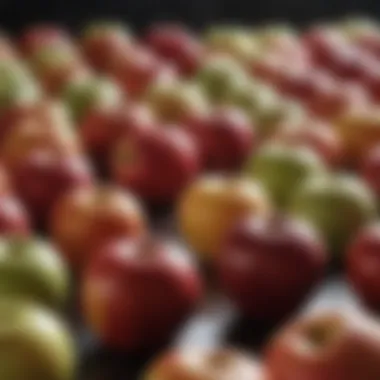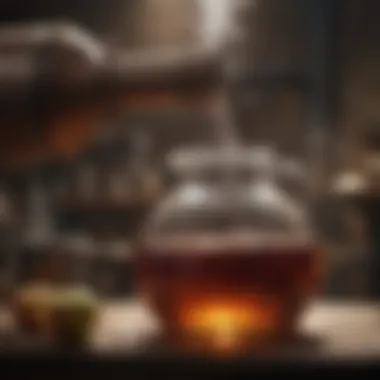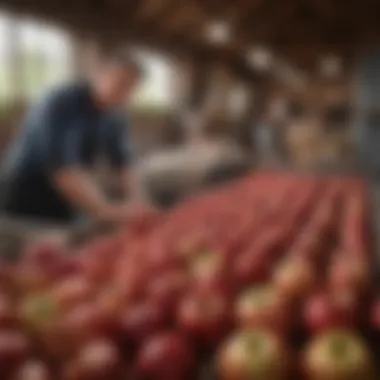Exploring Apple Alcohol: Varieties and Production


Intro
Apple alcohol encompasses an array of beverages that are deeply rooted in diverse cultures and traditions. The evolution of these drinks reflects not only the natural sweetness of apples but also intricate production methods that transform this common fruit into celebrated libations. Understanding the different types of apple alcohol, ranging from ciders to calvados, reveals insights into their unique characteristics and the nuances that define their flavors. This exploration invites readers to appreciate not just the taste, but also the story behind each type, including its origins and cultural significance.
Furthermore, the production techniques for apple alcohol vary significantly. Traditional fermentation methods contrast with modern innovations, each contributing to the final product’s flavor profile and aroma. Delving into the specific apple varieties suitable for these drinks adds another layer of complexity. Not every apple is created equal, and the choice of fruit can influence the quality and taste of the resulting beverage.
Equally important are the culinary aspects, including how apple alcohol complements food. Pairing these drinks with various dishes can elevate a dining experience, enhancing flavors and creating memorable meals. As the popularity of craft apple alcohol rises, so does its impact on local economies. The craft beverage movement emphasizes quality, diversity, and sustainability, leading to a renewed interest in regional apple cultivation and preservation of traditional practices.
In addressing health considerations, it is vital to examine the balance between enjoyment and responsibility. Apple alcohol, when consumed in moderation, can fit into a balanced lifestyle. This section sets the stage for a deeper understanding of apple alcohol, its varieties, production methods, and culinary uses that promote thoughtful appreciation during the tasting experience.
"Exploring the nuances of apple alcohol invites a greater appreciation for its cultural and culinary significance."
Understanding these elements prepares readers to dive deeper into each aspect, offering a comprehensive insight into the world of apple-alcohol beverages.
Preamble to Apple Alcohol
Apple alcohol has a rich history and a broad cultural significance that makes it much more than just a beverage. It encompasses a wide range of products, including cider, apple wine, and apple brandy. These drinks originate from apples, a fruit that grows plentifully in many parts of the world. Understanding apple alcohol not only includes knowing how it is made but also appreciating its role in different cultures and cuisines.
Apple alcohol is often associated with seasonal celebrations and gatherings, notably during harvest time. It brings people together, enhancing the enjoyment of meals and festivities. In this article, we will examine its many facets, diving into historical context, production processes, and culinary applications, thus providing a holistic view of this fascinating topic.
Historical Context
The history of apple alcohol is long and intertwined with the agricultural practices of different regions. The earliest records of fermented apple beverages date back to ancient civilizations. In Europe, particularly in France and England, cider has been produced for centuries, reflecting local customs and techniques. The settlers brought these traditions to America, where apple orchards became prominent.
The evolution of apple alcohol has been influenced by local cultures. Techniques for fermentation and production developed uniquely in various geographical areas. For example, the importance of cider in the culture of Normandy is vastly different from its significance in New England. Understanding these historical contexts reveals how apple alcohol has shaped social customs and economic practices over time.
Cultural Significance
Apple alcohol plays a critical role in many cultures. It is often featured in traditional celebrations and meals, connecting people to their heritage. In France, cider is enjoyed not just as a drink but as an integral part of meals, often paired with regional dishes. In the United States, apple cider is a staple during autumn festivals, symbolizing the harvest.
Furthermore, the cultural significance extends to local economies. Many regions that focus on apple alcohol production support local farmers and small businesses. The craft beverage movement has revived interest in ancient methods and specialty apple varieties, fostering a sense of community and pride among producers.
In summary, the exploration of apple alcohol is a journey through the past and present, revealing how this drink is interwoven with human experience, as well as its importance in both culinary and social realms.
Types of Apple Alcohol Drinks
The exploration of apple alcohol drinks encompasses a variety of unique beverages that have distinct flavor profiles and cultural significance. Understanding these types not only enhances one's appreciation for apple-based drinks but also informs choices for pairing and enjoyment in culinary settings. Each category offers a different experience, whether it’s through craft production, the diversity of flavors, or the traditions behind them.
Cider
Cider is one of the most popular apple alcohol beverages globally. It is made from fermented apple juice, and the process can vary significantly based on the type of apples used and the techniques applied. Cider can range from dry to sweet and can be still or sparkling, making it versatile for many occasions. The fermentation process typically takes a few weeks, during which natural yeast converts the sugars in apple juice into alcohol.
The importance of cider in this context cannot be overstated. Cider has a deep historical heritage and cultural significance, particularly in regions such as the United Kingdom and parts of France. In some places, it is more than just a drink; it is part of the local identity. Notably, artisanal ciders have seen an uptick in production, as craft cideries continue to emerge, offering diverse varieties that appeal to a wider audience.
When considering cider, factors like sugar content and acidity play crucial roles in determining its flavor profile. The characteristics of the apples chosen can greatly influence the final product. Varieties such as Granny Smith or Honeycrisp provide crispness, while others contribute more tannins and depth.
Some notable features of cider include:
- Variations in sweetness: Dry, semi-dry, and sweet options
- Carbonation levels: Still, sparkling, or even fruited ciders
- Cultural roots: Beverage traditions from various regions
Apple Wine
Apple wine presents another intriguing exploration within apple alcohol drinks. Unlike cider, apple wine tends to undergo a more intricate fermentation process that typically results in a higher alcohol content. It is often produced by concentrating the apple juice or blending different varieties to achieve unique flavors. The fermentation can last several months, leading to a complex character in the final product.
This beverage offers a distinct difference from cider, as the taste leans more towards the richness of wine. The crafting of apple wine can involve aging in barrels, which adds layers of flavor, akin to traditional grape wines. The versatility of apple wine in culinary applications is significant, as its complexity can complement a range of dishes, especially poultry and cheese plates.
Key distinctions and benefits of apple wine are:
- Higher alcohol content compared to cider
- Aging possibilities to enhance flavor
- Complex pairings with food, such as pork or aged cheeses
Apple Brandy


Apple brandy rounds out the spectrum of apple alcohol drinks with its unique distillation process. Unlike cider and apple wine, apple brandy undergoes a process of distillation that extracts alcohol from fermented apple mash, making it a spirit. This results in a stronger beverage, usually served in smaller quantities compared to cider and wine. Notable types of apple brandy include Calvados from Normandy, which is highly regarded for its refined taste and heritage.
The production of apple brandy combines elements of both cider making and distillation, making it particularly interesting. The choice of apple varieties and even the aging process in wooden barrels can significantly impact the final product, contributing to the drink’s depth and smoothness.
Some points to remember about apple brandy include:
- High alcohol content; typically, around 40% ABV
- Aged to soften and develop flavors
- Versatile use in cocktails or neat sipping
By understanding these different types of apple alcohol drinks, one gains insight into their unique qualities and their contexts within culinary experiences. Apple alcohol provides diverse options for consumers that cater to various tastes and occasions.
"Exploring the varieties of apple alcohol not only enhances culinary experiences but also connects us to rich traditions and craftsmanship."
Apple Varieties Used in Alcohol Production
The significance of apple varieties in alcohol production cannot be understated. Different types of apples contribute distinct flavors, aromas, and characteristics to the final product. Understanding these nuances helps producers craft beverages that stand out in the market. Moreover, the consumer's palate also benefits from this variety, as different apples can enhance the overall tasting experience. Therefore, the selection of apple types plays a critical role in producing quality alcoholic beverages, especially ciders, apple wines, and apple brandies.
Sweet versus Tart Apples
The choice between sweet and tart apples is fundamental in apple alcohol production. Sweet apples, like Fuji, tend to have higher sugar content, which can help in fermentation. This results in a smoother and less acidic beverage. However, tart apples, such as Granny Smith, bring higher acidity levels which can enhance complexity and balance. Depending on the style of the apple alcohol, the various flavor profiles can either complement or contrast with other ingredients.
When creating ciders or wines, a blend of both sweet and tart apples is often desired. It offers depth in flavor, contributing to richer sensory experiences. Additionally, sweet apples may require more fermentation time, whereas tart varieties can ferment faster, impacting production timelines.
Popular Apple Varieties
Granny Smith
Granny Smith apples, well-known for their bright green skin, provide a unique tartness ideal for alcohol production. Their high acidity enhances the overall balance when fermented, making them a popular choice for cider makers. The tartness is appealing to many consumers who enjoy crisp flavors. However, their strong tang can sometimes overshadow other subtle notes in blends if not used wisely. In summary, Granny Smith apples play a crucial role in creating refreshing and lively cider.
Fuji
Fuji apples rank high in popularity due to their sweetness and juiciness. They contain a higher sugar content, which aids in fermentation, making the process smoother. The natural sweetness also attracts a broader audience, especially those who prefer lighter and sweeter beverages. Nonetheless, the flavor profile can be less complex compared to using tart varieties. When used correctly, Fuji apples can create a delightful and accessible apple wine that many appreciate.
Golden Delicious
Golden Delicious apples are cherished for their balanced flavor. They have a mild sweetness that appeals to many. This apple’s versatility allows it to be used in various apple alcohol products, adding depth without overwhelming other flavors. However, their lower acidity may lead to overly sweet products if not combined with more acidic apples. Thus, careful blending is essential. Golden Delicious can contribute to beverages that appeal to consumers looking for a softer taste.
"The right apple variety used in alcohol production can elevate the drink from basic to extraordinary."
The Production Process
Understanding the production process is vital when it comes to apple-based alcoholic beverages. Each stage—harvesting, fermentation, and distillation—carries significant weight as it influences the final product's flavor, quality, and character. The methods employed can vary greatly among cideries and distilleries, which adds depth to the conversation about apple alcohol. By delving into these processes, we not only appreciate the craftsmanship involved but also recognize how tradition and innovation coalesce to create diverse varieties of apple alcohol.
Harvesting and Selecting Apples
Harvesting is the first crucial step in producing apple alcohol. The timing of the harvest can heavily influence the flavor profile. Apples are best harvested when they reach their peak ripeness. This can vary by variety, with some apples meant for alcohol production needing more time on the tree compared to those eaten raw. During this stage, apple selection is critical.
Factors to consider when selecting apples include:
- Variety: Different species of apples deliver unique taste elements. Not all apples are created equal for alcohol making. Sweet apples may provide the sugar needed for fermentation, whereas tart varieties can add complexity.
- Quality: Each apple should be inspected for blemishes or signs of decay, which can spoil the alcoholic beverage.
- Freshness: Recently picked apples yield the best flavors—allowing for a more vibrant end product.
Fermentation Techniques
After the apples are harvested and selected, they go through fermentation, a transformative process where sugars convert into alcohol. The method of fermentation can range from traditional open fermentation to controlled environments using precise temperatures. This process is where the character of the apple alcohol significantly develops.
Key fermentation techniques include:
- Wild Fermentation: Utilizing natural yeasts present on the apple skin and in the environment. This can create a more complex flavor but is harder to control.
- Cultured Yeasts: Many producers opt for specific strains of yeast to achieve predictable flavors and consistency in their products. This method can provide a cleaner finish and more controlled alcohol levels.
- Temperature Control: Managing fermentation temperatures is crucial. Cooler temperatures often yield more aromatic and delicate flavors, while warmer fermentation can boost alcohol content but may lead to more pungent profiles.
Distillation Process
For those producing apple brandy or high-proof apple spirits, the distillation step is where the concentration of flavors occurs. This process separates alcohol from the fermented apples. Distillation is often seen as both an art and a science.
Highlights of the distillation process include:


- Types of Distillation: Some producers use pot stills, which tends to retain more flavor compounds. Others might utilize column stills for higher efficiency and cleaner spirits.
- Cut Points: Distillers must make decisions on when to collect the distillate. The heads (initial output) and tails (final output) can have undesirable flavors, while the heart is the desired product used for aging or bottling.
- Aging: After distillation, many apple spirits undergo aging in barrels. This maturation process further influences the taste, leading to more complex characteristics as it absorbs flavors from the wood.
"The production process of apple alcohol is a blend of nature's bounty and human expertise. Each step shapes the final taste and character of the beverage."
By comprehensively understanding these processes, one appreciates the craft, dedication, and science behind producing various styles of apple alcohol. The diversity in production methods ensures that whether you prefer a crisp cider or a smooth apple brandy, there is a unique drink suited to your palate.
This engaging narrative behind the production of apple alcohol sets a foundation for exploring its culinary uses, regional variations, and future trends.
Craft Production Trends
Craft production trends play a pivotal role in shaping the landscape of apple alcohol. With the rise of small scale producers, we see a compelling shift in methodology, ingredients, and choice of flavors. This transformation is not just about making drinks; it’s about redefining how these beverages fit into our culture and dining experiences. Craftspeople focus on quality over quantity. They emphasize local ingredients, sustainability, and innovation, showcasing unique profiles that mass-produced drinks often lack.
The benefits of craft production are numerous. First, craft cideries and other producers foster regional economies by sourcing local apples and employing local workers. This creates jobs and supports local farmers. Additionally, the connection between producers and their communities enhances appreciation for apple alcohol. Consumers are increasingly valuing authenticity and transparency in what they drink, and craft production delivers on both.
However, there are considerations to keep in mind. With this trend, challenges such as consistency and scalability may arise. As craft producers experiment with various techniques, flavors, and ingredients, maintaining a consistent quality can be difficult. This situation may lead to fluctuations in product quality, which can impact consumer trust over time.
The Rise of Craft Cideries
Craft cideries have gained momentum over the past decade. These establishments prioritize artisanal methods and small-batch production. They tend to produce cider that reflects local terroir, which attracts enthusiasts who seek diverse tasting experiences. Cideries may explore blends of apple varieties, allowing for a broader range of flavors. The appeal is not limited to taste; the stories behind these cideries create a connection with consumers. Many craft cideries host events and tastings that deepen this relationship, creating a loyal customer base.
Moreover, craft cider production fosters innovation. Whether it’s creating a more robust cider or combining apples with other fruits, the experimentation leads to exciting new products. This not only satisfies existing customers but also attracts those who may be new to apple alcohol. In this environment, creativity flourishes, distinguishing craft cider from mass-market alternatives.
Innovative Flavor Profiles
With the rise of craft cideries comes the opportunity for innovative flavor profiles. Producers are no longer limited to traditional apple cider. Instead, they explore a plethora of ingredients that enhance and transform the basic apple flavor. Additional fruits such as raspberries, ginger, and even herbs like rosemary are being infused into ciders, providing unique taste experiences that excite the palate.
Taste innovation in apple alcohol is not limited to flavor additions. Techniques like barrel aging add complexity, bringing in notes from the wood and any previously stored liquids. This wild card in flavor complexity captivates many consumers. In contrast, some craft producers embrace a more minimalist approach, allowing the true essence of the apple to shine through unmasked.
Craft producers are also tapping into seasonal elements. Limited releases of cider that highlight apples at their peak maturity or incorporate festive spices for autumn mirror a growing consumer desire for seasonality and tradition. This approach ensures that every drink has a distinct mark of its time, creating anticipation and exclusivity.
"Craft apple beverages are about more than just flavor; they are a reflection of culture, creativity, and community engagement."
Given this landscape of diversity and exploration, enthusiasts are more informed and open-minded than ever. They seek not just a beverage, but an experience that resonates with their tastes and values. As these trends continue to evolve, apple alcohol will likely maintain its significance in both local and global contexts.
Health Considerations
Understanding health considerations related to apple alcohol is crucial for consumers and producers alike. Apple-based beverages, such as cider and apple wine, are subject to various health discussions primarily concerning their consumption and potential effects on well-being. A comprehensive grasp of these elements can help individuals enjoy these drinks responsibly while benefiting from their positive aspects.
Moderation in Consumption
Moderation is a critical principle for anyone who indulges in apple alcohol. Like all alcoholic beverages, apple alcohol can have detrimental health effects when consumed excessively. Overconsumption can lead to a range of health issues such as liver disease, addiction problems, and other complications.
It is advisable to follow recommended guidelines. The Centers for Disease Control and Prevention (CDC) suggests that adults limit alcohol intake to one drink per day for women and two drinks per day for men. This guideline applies to various types of apple alcohol, including cider, apple wine, and apple brandy.
Ultimately, understanding and respecting moderation can allow consumers to enjoy apple alcohol without risking their health, which adds an important layer of responsibility when engaging in this pleasurable activity.
Potential Health Benefits
Despite the negative impacts of excessive drinking, moderate consumption of apple alcohol can offer certain health benefits. Research suggests that some apple-based alcoholic drinks may contribute to cardiovascular health.
These drinks often contain antioxidants, primarily from the apples used in their production. Antioxidants can help combat oxidative stress in the body, potentially reducing the risk of chronic diseases. Moreover, the polyphenols found in apples have been linked to improved heart health by inhibiting bad cholesterol and enhancing circulation.
Here are some specific potential benefits of moderate apple alcohol consumption:
- Cardiovascular Support: May improve heart health when consumed in moderation.
- Rich in Antioxidants: Apples are a great source of antioxidants, which can enhance overall health.
- Social Benefits: Sharing apple alcohol during social gatherings can promote bonding and positive social interactions.
In summary, while a cautious approach to consumption is vital, the moderate intake of apple alcohol can provide some health benefits, making it a topic worth exploring for both enthusiasts and casual drinkers.
Pairing Apple Alcohol with Food
Pairing apple alcohol with food is essential to enhance the dining experience. This topic bridges the gap between taste, aroma, and culinary creativity. Understanding how the flavors of apple-based beverages complement different dishes can elevate a meal. When pairing, one must consider the acidity, sweetness, and complexity of the drink.


The benefits of proper pairing include increased enjoyment and a balanced palate. It also opens new horizons for culinary exploration, encouraging home cooks and chefs alike to experiment with flavors.
Considerations should include the intensity of the dish. A light cider may be lost when paired with a heavy meal, while a robust apple brandy can stand strong against rich foods. The aim is to create harmony on the plate, not overpower it. Each variety of apple alcohol has unique characteristics that deserve careful thought.
"Pairing is not just about taste; it’s about creating an experience that delights the senses."
Cider Pairing Recommendations
Cider is versatile and works well with a range of dishes. Consider these pairings:
- Pork Dishes: The acidity in cider cuts through the fattiness of pork. A dry cider provides balance.
- Cheese: Hard cheeses like aged cheddar pair excellently with sharp ciders. Soft cheeses offer a beautiful contrast with fruitier styles.
- Salads: A light, effervescent cider complements salads, particularly those with vinaigrette dressing.
In seasonal cooking, bitter herbs and spices in fall dishes can be complemented beautifully by spiced cider, offering depth to the meal.
Apple Wine Complementary Dishes
Apple wine's profile suits various foods. Here are some dishes that enhance its flavors:
- Grilled Chicken: Light-bodied apple wine enhances the smoky notes.
- Duck: A richer apple wine pairs well with duck, especially when prepared with fruity sauces.
- Desserts: Pairing apple wine with desserts like tarte tatin or vanilla ice cream brings out the wine's sweetness.
Looking at regional cuisines, apple wine can vary in flavor. Therefore, pairing it with local ingredients maximizes its character.
Emphasizing the right pairings not only celebrates the apple alcohol but also honors the food, creating memorable meals.
Regional Variations
The concept of regional variations in apple alcohol production is crucial for understanding the diverse landscape of apple-based beverages. Different regions apply unique methods, local apple varieties, and cultural practices that influence the flavor profiles and overall experience of these drinks. By examining these variances, one gains insight into not just the beverages themselves but also the local traditions and economies intertwined with their production.
United States Production
In the United States, apple alcohol production has witnessed significant growth over recent years. The focus has primarily been on cider, which has become increasingly popular in craft beverage circles. The U.S. cider market is diverse, incorporating various apple types, each contributing distinct flavors. Key regions like the Pacific Northwest, particularly Washington, are known as leading apple producers. Here, the cold climate and rich soil conditions yield apples with high sugar content, ideal for fermentation.
Craft cider makers in the U.S. often experiment with blends using both traditional and non-traditional apple varieties. This practice enriches the flavor spectrum, attracting adventurous palates and enhancing the culinary experience. Additionally, many cideries prioritize local and sustainable farming, thereby supporting regional agriculture and economy while producing high-quality drinks.
"Cider is more than beverages; it reflects the land, the craftsmanship, and the passion of local producers."
European Cidermaking Traditions
In Europe, cider-making has deeper roots, particularly in countries like the United Kingdom, France, and Spain. Traditional methods have been perfected over centuries. English cider, for instance, is noted for its sour and bitter apple varieties, which impart robust flavors. The semi-dry style is common, producing ciders that are refreshing yet complex.
French cider, particularly from the Normandy region, showcases artisanal techniques. The use of specific apple varieties such as bittersweets and sharps creates harmonious blends. Calvados, an apple brandy from Normandy, highlights distillation practices that transform the essence of apples into more potent spirits.
Spanish sidra presents a unique twist, emphasizing tart apples that lend sharpness to the final product. Each region celebrates its heritage through cider culture, offering variations that reflect both the landscape and the historical practices of their people.
The appreciation of apple alcohol goes beyond taste. It encapsulates geography, history, and community, creating a rich tapestry for enthusiasts and consumers alike.
The Future of Apple Alcohol
The evolution of apple alcohol reflects broader shifts in consumer behavior and environmental considerations. As the world becomes increasingly aware of sustainability and local sourcing, there is a growing interest in apple-based alcoholic beverages. This trend is not just a fleeting moment; it presents long-term benefits for producers and consumers alike. Emphasizing sustainability and adapting to market trends will shape the future landscape of apple alcohol.
Sustainability in Production
Sustainable production practices are crucial for the future of apple alcohol. As conventional methods face criticism for their environmental impact, many producers are turning to more eco-friendly approaches. These methods often prioritize organic farming, reducing chemical pesticide use, and embracing regenerative agriculture.
Key elements of sustainable production include:
- Soil Health: Maintaining healthy soil through composting and cover cropping enhances the quality of apples while promoting biodiversity.
- Water Conservation: Efficient irrigation techniques reduce water waste, essential in many regions facing shortages.
- Waste Reduction: Many cideries and distilleries are adopting practices that minimize waste, such as repurposing byproducts from fermentation.
Choosing to support sustainable apple alcohol producers allows consumers to enjoy their favorite beverages while contributing to environmental preservation. The connection between sustainable practices and product quality is becoming clear—better farming leads to better flavor.
Market Trends and Consumer Preferences
As consumer preferences evolve, the market for apple alcohol reflects these changes. Today's consumers prioritize not only quality and flavor but also transparency and ethical sourcing. Trends indicate that consumers are moving towards:
- Craft and Local Options: There is a surge in interest in locally produced ciders and apple wines. Many consumers seek out small, artisanal producers.
- Diverse Flavor Profiles: Innovation in flavor combinations is essential. The incorporation of spices, herbs, and other fruits allows brands to distinguish themselves in a crowded market.
- Health Consciousness: Consumers increasingly favor lower-alcohol options and beverages made from organic apples, responding to a broader trend of health and wellness.
"Understanding and anticipating consumer preferences will be essential for success in the apple alcohol industry."
The future of apple alcohol is bright, with potential for growth driven by sustainability and consumer demand for quality over quantity. Being aware of these trends will better equip producers and consumers to navigate this evolving landscape.







